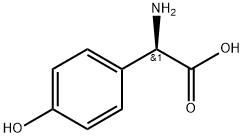
Products
4-Hydroxy-D-(-)-2-phenylglycine

Phenylglycine Chemical Properties
| Melting point | 240 °C (dec.)(lit.) |
| alpha | -156 º (c=1, 1 N HCl) |
| Boiling point | 295.73°C (rough estimate) |
| density | 1.396 |
| vapor pressure | 0Pa at 25℃ |
| refractive index | -158 ° (C=1, 1mol/L HCl) |
| storage temp. | 2-8°C |
| solubility | 5g/l |
| pka | 2.15±0.10(Predicted) |
| form | Liquid |
| color | Clear colorless to yellow |
| optical activity | [α]23/D 158±3°, c = 1 in 1 M HCl |
| Water Solubility | 5 g/L (20 ºC) |
| BRN | 2210998 |
| LogP | -2.25 |
| CAS DataBase Reference | 22818-40-2(CAS DataBase Reference) |
| EPA Substance Registry System | Benzeneacetic acid, .alpha.-amino-4-hydroxy-, (.alpha.R)- (22818-40-2) |
Safety Information
| Hazard Codes | Xi |
| Risk Statements | 36/37/38 |
| Safety Statements | 26-36-24/25 |
| WGK Germany | 3 |
| TSCA | Yes |
| HS Code | 29225000 |
Phenylglycine Usage And Synthesis
| Chemical Properties | off-white powder |
| Uses | 4-Hydroxy-D-(-)-2-phenylglycine is an compound used mainly for the synthetic preparation of β-lactam antibiotics. |
| Uses | 4-Hydroxy-D-(-)-2-phenylglycine (Cefadroxil EP Impurity A(Amoxicillin EP Impurity A)) is an compound used mainly for the synthetic preparation of β-lactam antibiotics. |
| Definition | ChEBI: The D-enantiomer of 4-hydroxyphenylglycine. A non-proteinogenic amino acid found in Herpetosiphon aurantiacus. |
| Flammability and Explosibility | Nonflammable |
| Purification Methods | Crystallise it from water and dry it in vacuo. [Beilstein 14 I 659.] |
Write your message here and send it to us







